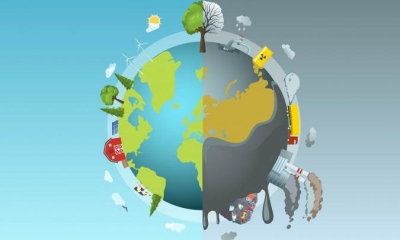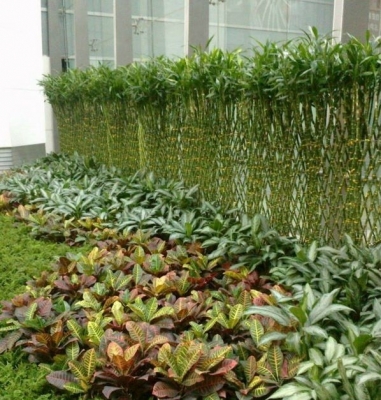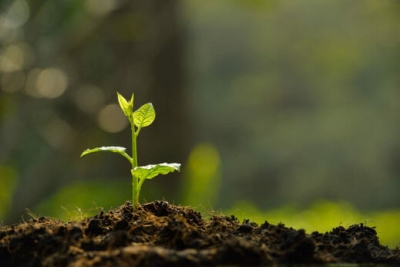
Earth has undergone many environmental changes in its history. But the current ones are being caused by one species: humans. Our activities contribute to global warming, climate change, extreme weather events, species extinction, resource depletion, and what not. Let's take a closer look at six of them to mark Earth Day, observed on April 22.
1. POLLUTION
Since the industrial revolution, environmental pollution has been on the rise. Pollution is the introduction of harmful contaminants into the environment that negatively alters our surroundings. While pollution can take several forms, such as light and noise, the three major types are air, land, and water pollution. Humans contribute to each of these every day. Pollution affects biodiversity, ecosystems, and human health worldwide. Air pollution is attributed to 11.65% of deaths globally, for instance. Vehicular and industrial emission, and basically, our dependence on fossil fuel for energy, is the chief cause of air pollution. While water pollution comes from sewage, chemicals, agricultural runoffs, etc. land pollution is caused by indiscriminate dumping of garbage, toxic materials, and industrial waste. Not to mention the harm caused by plastic pollution to marine and terrestrial life. As economies and population grow, pollution too increases at an alarming rate globally.
2.GLACIER MELT AND SEA-LEVEL RISE
Nineteen of the warmest years in the recorded history of the planet has occurred since 2000. Models predict that as the world consumes more fossil fuel, greenhouse gas concentrations will continue to rise, and Earth's average surface temperature will rise with them. Average surface temperatures could rise between 2°C and 6°C by the end of the 21st Century. A warmer atmosphere causes glaciers and polar ice sheets to melt rapidly. Glacial melt has a direct impact on freshwater flow because glaciers store water in the form of ice during the colder seasons and release it during warmer seasons by way of melting. This serves as a water source for humans, animals, and vegetation. Glacier melt also contributes to unusual rise in sea level. The impact of sea-level rise includes flooding of coastal areas, increased soil erosion, disappearance of some low-lying islands, saltwater intrusion, and habitat destruction in coastal areas, which, in turn, can affect coastal ecosystems.
What can you do?
A few tips on how we can reduce our impact on global warming: 1. Urge your parents to switch to renewable sources such as solar to power your home.
2. Use energy-efficient appliances at home and school
3. Support local businesses that use and promote sustainable, climate-smart practices
3. DEFORESTATION
Deforestation is the destruction of forests in order to make the land available for other uses. Earth loses 18.7 million acres of forests per year, which is equal to 27 football fields every minute, according to the World Wildlife Fund. Farmers clear forests to use the land for agriculture. Trees are cut for mining. for use as fuel. housing, and urbanisation, contruction of dams and infrastructual projects, and for making furniture. Deforestation is considered to be one of the contributing factors to global warming and climate change. Trees absorb not only the carbon dioxide that we exhale, but also the other heat-trapping greenhouse gases that human activities emit. With increase in deforestation, larger amounts of these gases will enter the atmosphere and global warming will increase further. As much as 70 % of the world's plants and animals live in forests. They are losing their habitats due to deforestation. Loss of habitat can lead to species extinction.
What can you do?
1. Plant saplings
2. Go paperless
3. Go for used-furniture instead of buying new ones every time.
4.WATER CRISIS
If global temperatures continue to rise, rainfall will increasingly become a thing of extremes: long dry spells here. dangerous floods there and in some places, intense water shortages. This will also affect agriculture. Worldwide, farmers are struggling to keep up with shifting weather patterns and increasingly unpredictable water supplies. Extreme weather patterns also destroy life, property. and livelihood. The rapid increase in population and the massive growth in the industrial sector have increased the demand for water multifold. Overexploitation and wastage of water are major issues, especially in urban areas. A UN report says that at least two billion people live in countries with high water stress. That is more than a quarter of the world population. Ecosystems and biodiversity are threatened by the scarcity of water resources. Water crisis can also lead conflict between States that share water sources such as river.
What can you do?
1. Do not waste water
2. Fix leaking tap and try to reuse water wherever possible
3. Urge your parents to install rainwater harvesting facility
4. Don't pollute water: Do not dump household solid waste or oil and chemicals into the drainage system. Do not litter. They are likely to end up in a waterbody.
5.WILDFIRE
As warmer temperatures increase evaporation, the land becomes drier and drier, enhancing the chances of wildfires. The intense, destructive fires that have dominated headlines in recent years are expected to become more frequent, even in places such as the Arctic. Extreme fires are projected to rise up to 14% by 2030 and 30% by mid-century, according to a new report by the UN Environment Programme.
Wildfires not only destroy forests and cause loss of life, they emit large amounts of greenhouse gases such as CO2, methane, and carbon monoxide. The smoke from burning vegetation can pose serious risks to respiratory health. Animals are directly impacted by wildfire. They lose their life or their home and food source.
What can you do?
1. Build your campfire in an open location and far from flammables
2. Do not contribute to global warming
3. Avoid burning wastes around dry grass.
6. WILDLIFE TRADE
Wildlife trade is a big business, run by international networks. Animals and birds are trafficked across the globe for meat, skin, bone, fur, and other body parts. In addition, many species are sold as pets. Experts at TRAFFIC, the wildlife trade monitoring network, estimate that the illegal wildlife commerce runs into billions of dollars. Wildlife trafficking threatens the survival of some of the Earth's most iconic species: tiger, elephant, rhinoceros, pangolin, etc. It affects food chain and threatens the local ecosystem. Wildlife trade also increases the chances of human-animal contact, putting humans at the risk of contracting diseases. COVID-19 was linked to wildlife trade and eating of wildlife. People who handled, killed, and sold wild animals made up nearly 40 % of the first cases of SARS. Poorly regulated wet markets and illegal wildlife trade offer a unique opportunity for viruses to spill over from wildlife hosts into the human population.
What can you do?
1. Create awareness among the public about wildlife trade.
2. Say no to exotic pets. They may have been trafficked and kept in unsafe conditions before being sold.
3. Avoid buying things made from ivory, horns, and leather. This discourages illegal trading.
Picture Credit : Google



